
SkillShift
Industry
Education
Contribution
UI/UX Design
Duration
2 - 3 Weeks
Platform
Mobile App
Designing a Seamless Barter Experience for Freelancers
At SkillBarter, the goal was to create a platform for exchanging skills without money, fostering a community of mutual learning. Early users struggled with understanding how to initiate trades and build trust, leading to low engagement. Instead of relying on paid growth, I proposed a UX redesign to simplify the barter flow, highlight trust signals, and make value exchange intuitive—turning confusion into meaningful, organic participation.
Challenges
How might we design a seamless and trustworthy experience that enables users to easily discover, offer, and exchange skills—without money—while fostering genuine connections and encouraging ongoing engagement in a barter-based community?
The Proposal
A skill-barter platform designed for speed, simplicity, and meaningful exchanges. The more specific your preferences, the smarter the matches. The app combines:
- Seamless login and onboarding to reduce entry barriers
- Smart matching based on skill preferences and availability
- A streamlined request flow to propose or accept barters in just a few taps
- Lightweight profiles that focus on skills, not resumes
Designed For
SkillBarter is built for freelancers and independent professionals who want to trade services without money. Whether it's design for copy, coding for coaching, or marketing for video editing, the platform helps skilled individuals connect, collaborate, and grow—quickly and cost-free.

Step 1: Building an understanding of freelancers and their needs
I started by digging into the mindset and pain points of freelancers—independent professionals who value flexibility, skill growth, and low-cost solutions. Bartering made sense, but only if the process felt fast, fair, and safe. This insight shaped a product experience designed for trust, speed, and real value exchange.
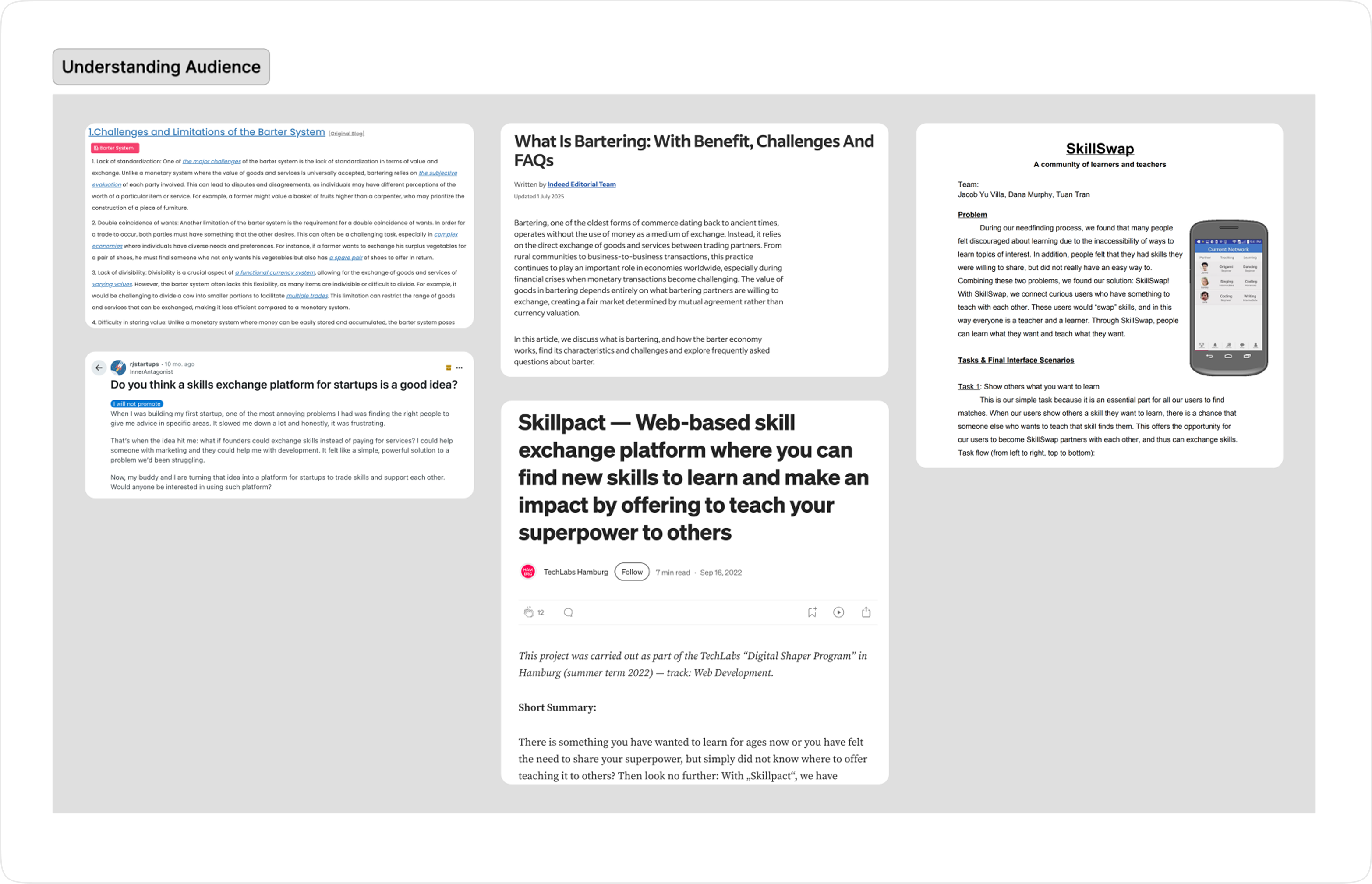
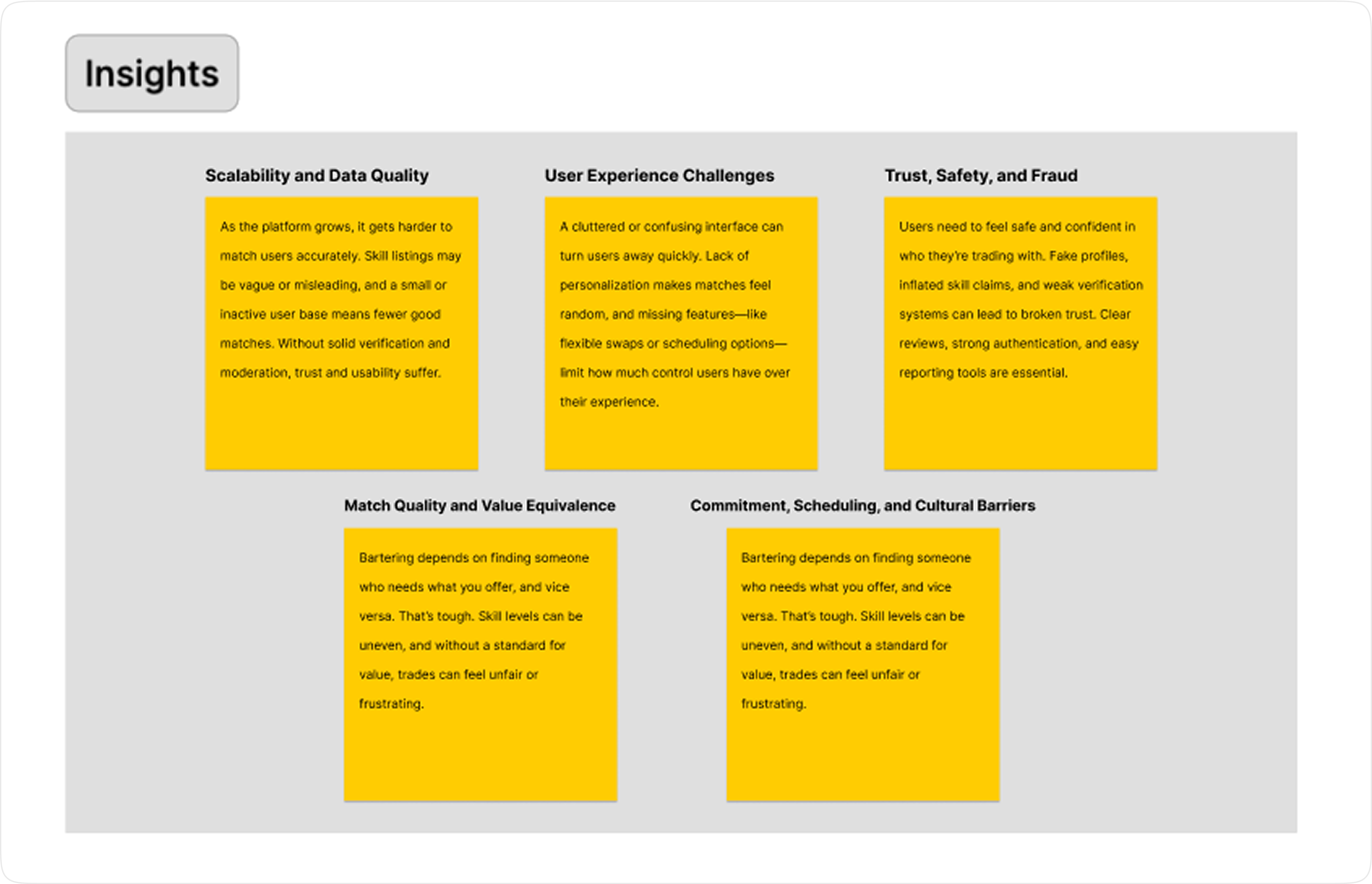
Insights I Got…
We consolidated our qualitative observations into thematic insights:
Trust as Currency :
Freelancers are more open to bartering when there's visible trust—profiles with endorsements, clear communication, and defined expectations build confidence.
Barter Isn't One-Size-Fits-All :
Some users want quick, one-time trades, while others look for longer-term skill partnerships. Matching expectations, commitment, and work styles is key.
Simplicity Wins :
A clean, focused experience matters. Freelancers have limited time, and they disengage quickly if the platform feels clunky, confusing, or effort-heavy.
Value is Personal :
Perceived fairness drives satisfaction. Users are okay with uneven exchanges—as long as terms are clear, and both sides feel they're getting value.
Niche Comfort Zones :
Users often prefer bartering within familiar fields or industries where they share a language, culture, or creative workflow, making collaboration smoother.
Legal & ethical considerations
Intellectual Property Rights :
Ensure users retain ownership of their work (designs, code, content) unless explicitly agreed otherwise, in line with the Indian Copyright Act, 1957.
Contractual Clarity :
Even bartered services are considered contracts under Indian law. Terms should be clear, mutual, and documented to avoid legal ambiguity (Indian Contract Act, 1872).
Data Privacy Compliance :
Handle personal data as per India's Digital Personal Data Protection Act, 2023 — with user consent, purpose limitation, and secure storage.
Non-Monetary Exchange Ethics :
While bartering avoids monetary transactions, platforms must avoid enabling exploitative or unfair exchanges—especially where there's a power or skill imbalance.
Inclusive & Non-Discriminatory Access :
Ensure the platform promotes fair use across diverse communities, in line with India's anti-discrimination principles under Articles 14 and 15 of the Constitution.
Information Architecture

UX Audit of Skill Barter Competitors
Evaluating how current platforms approach interaction, language, and trust.

Key User Journeys
Visual breakdowns of primary actions users take to explore, connect, and exchange skills seamlessly.

Visual Design Showcase
Polished UI screens that bring the product experience to life through consistent style, structure, and UX principles.
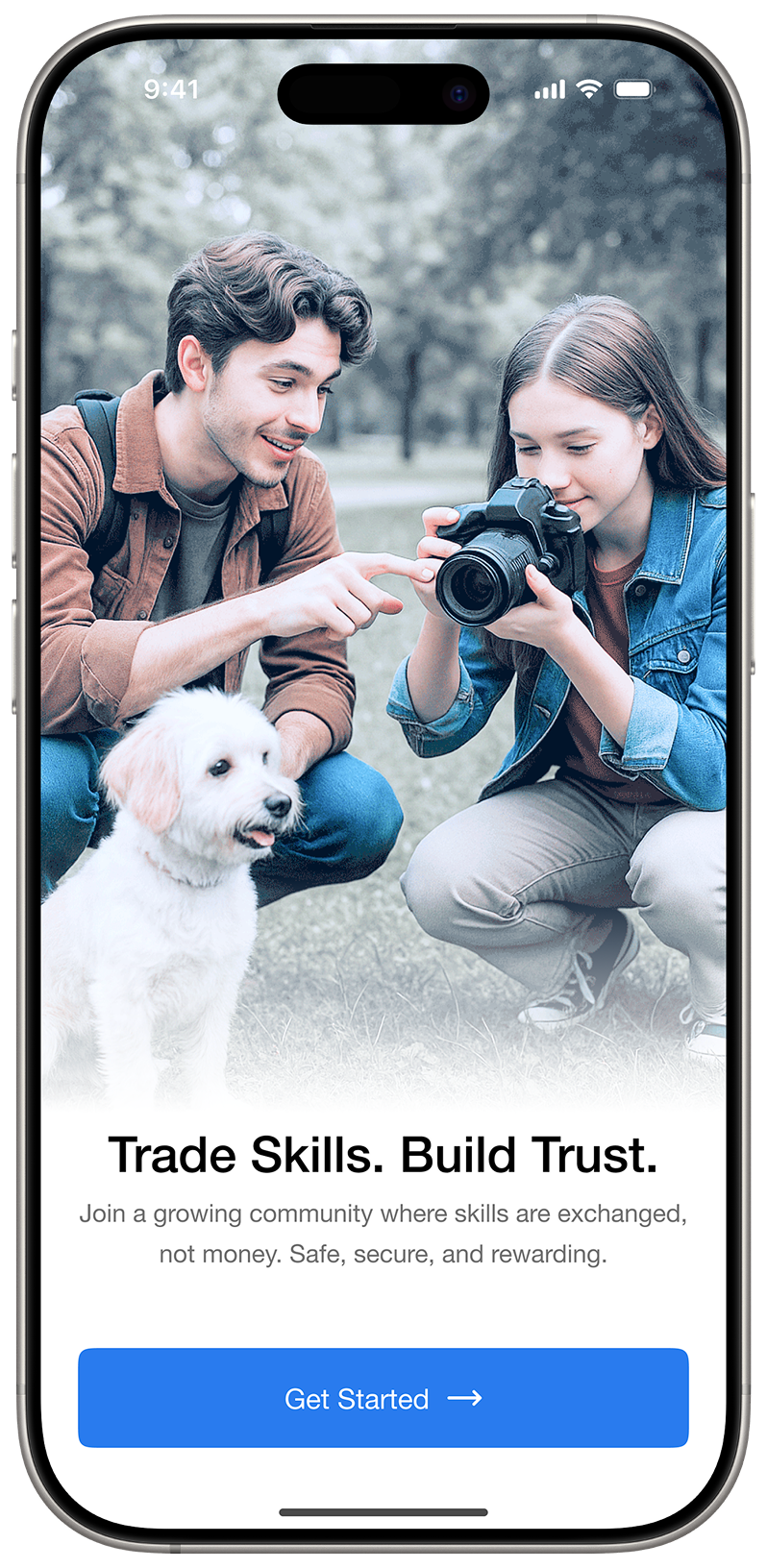
First Impressions with Focus
Minimal copy and strong visuals quickly introduce the app's purpose, ensuring users understand the concept before signing up.
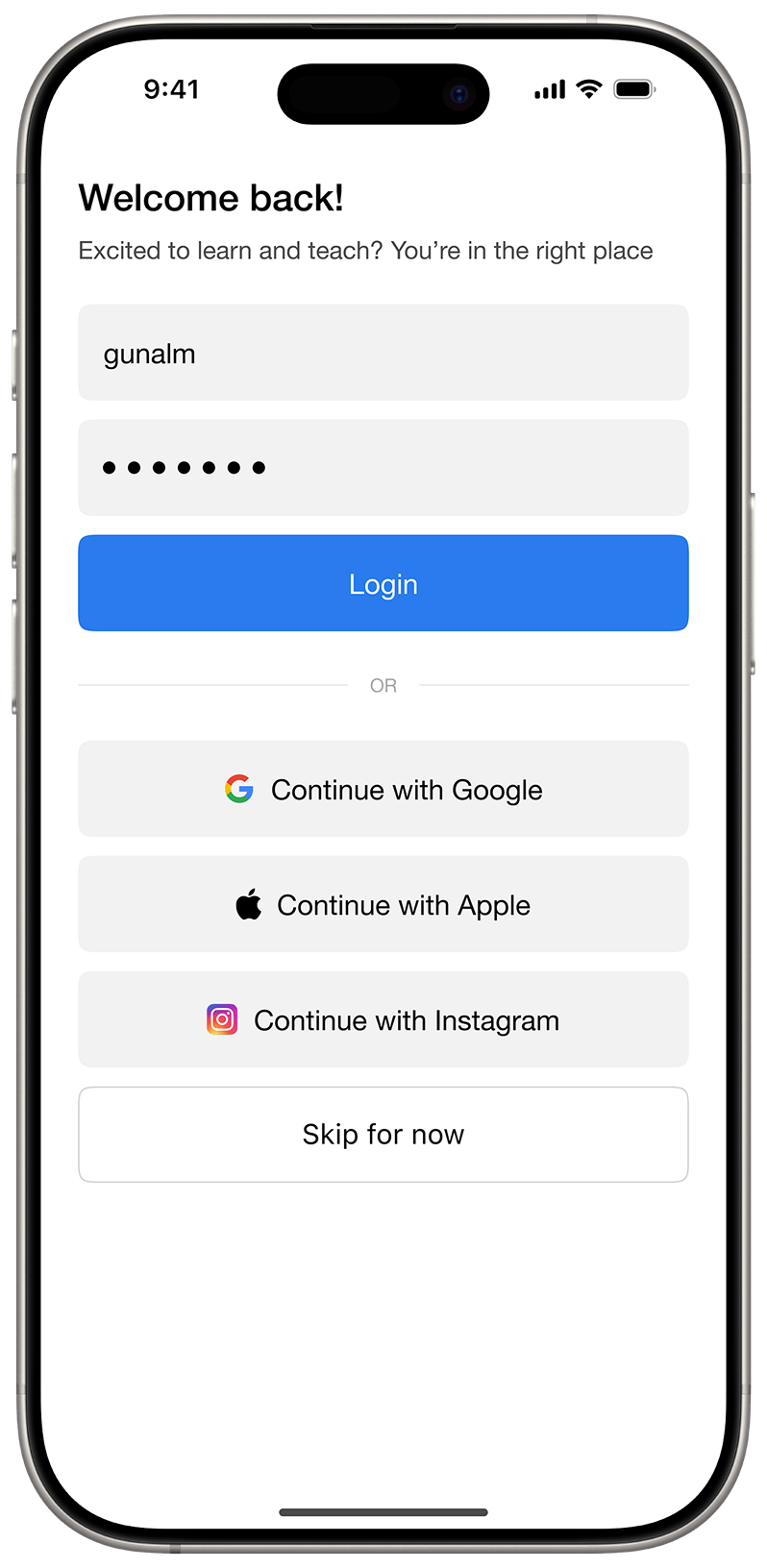
Login, But on Your Terms
By allowing users to skip login temporarily, we empower them to experience the app's value first — building trust before conversion.
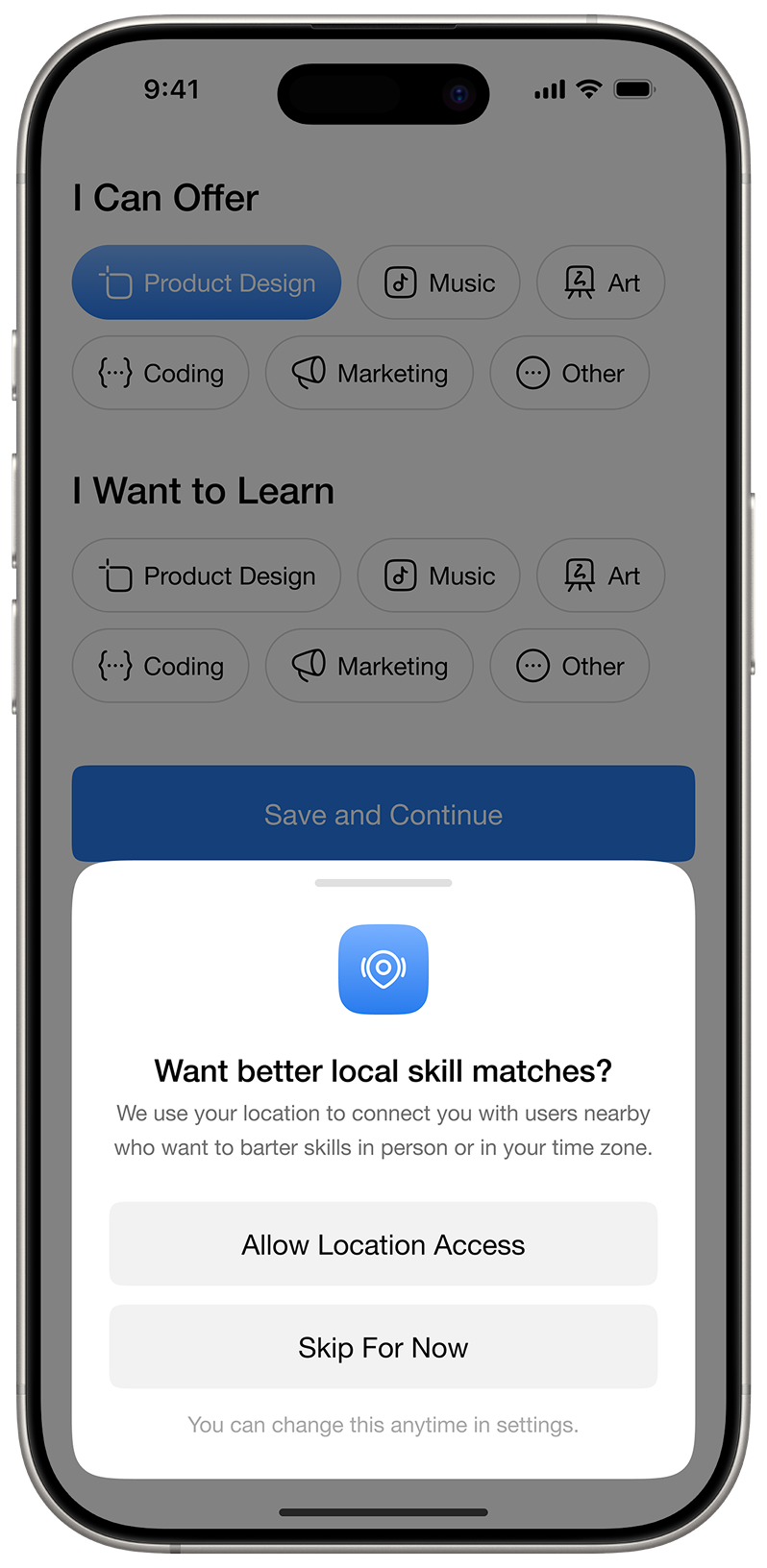
Context-Aware, Consent-First UX
Location is positioned as a way to improve user experience — not a blocker. The screen respects privacy and lets users opt in on their terms, making trust a design decision.
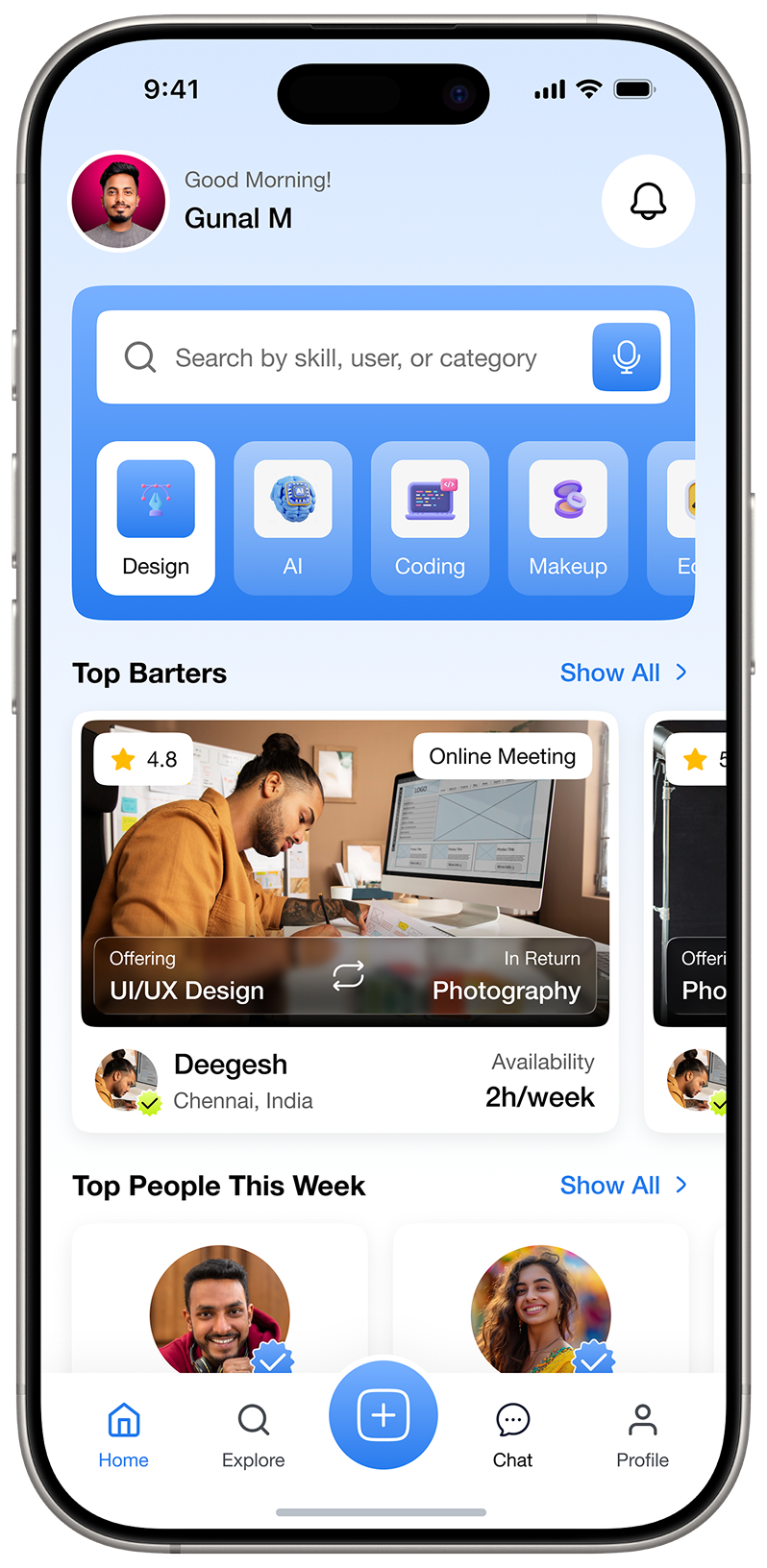
Engagement Starts Here
From personalized top barters to this week's most active users, every section of the home screen is crafted to help users discover value and start bartering faster.
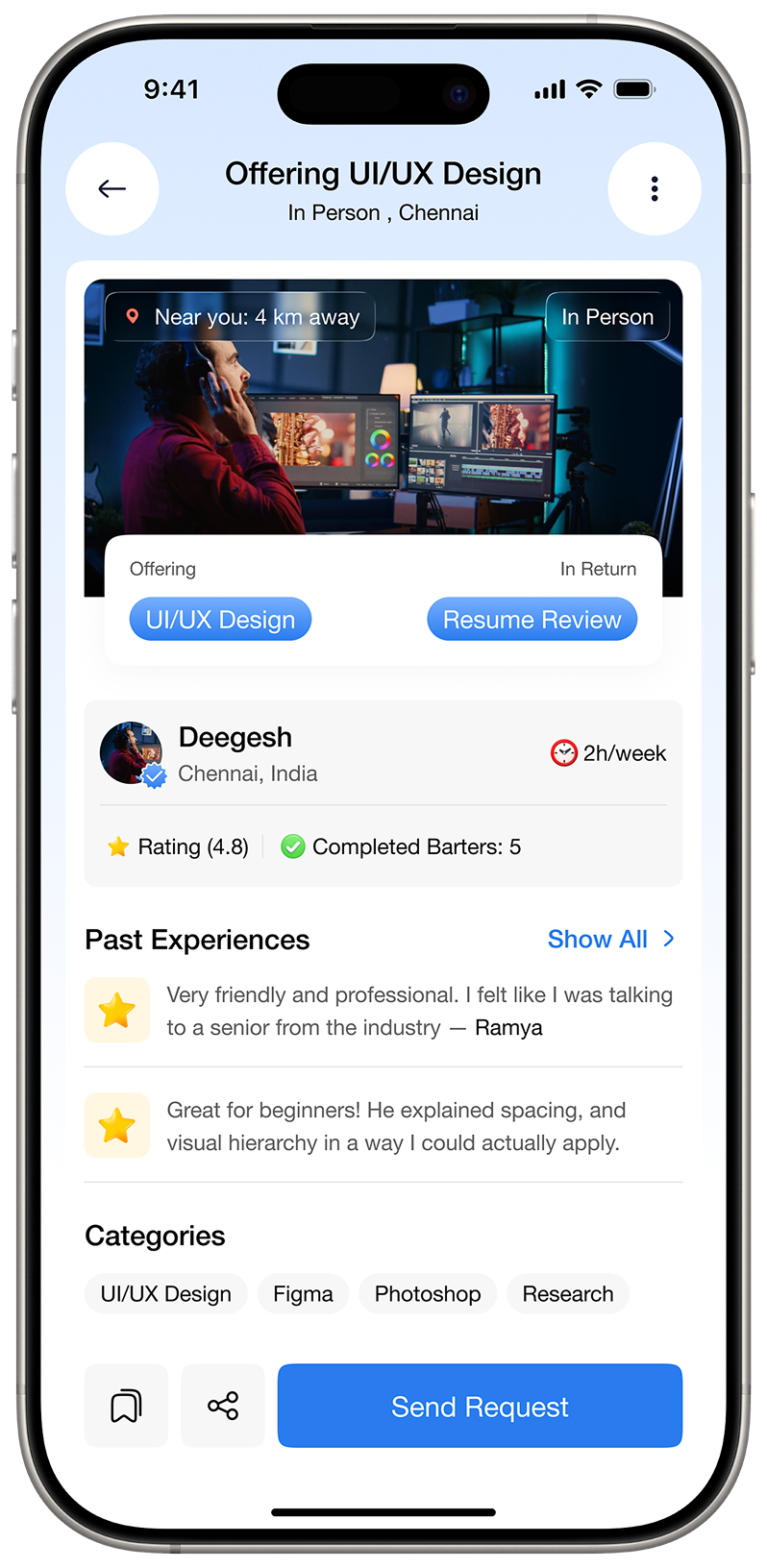
Detailed, Trust-Focused Barter View
A clear barter summary with cover image, user credibility via ratings and reviews, and contextual chips makes it easy to evaluate. Micro-actions (Save, Share) support passive interest, while "Send Request" drives the primary flow.
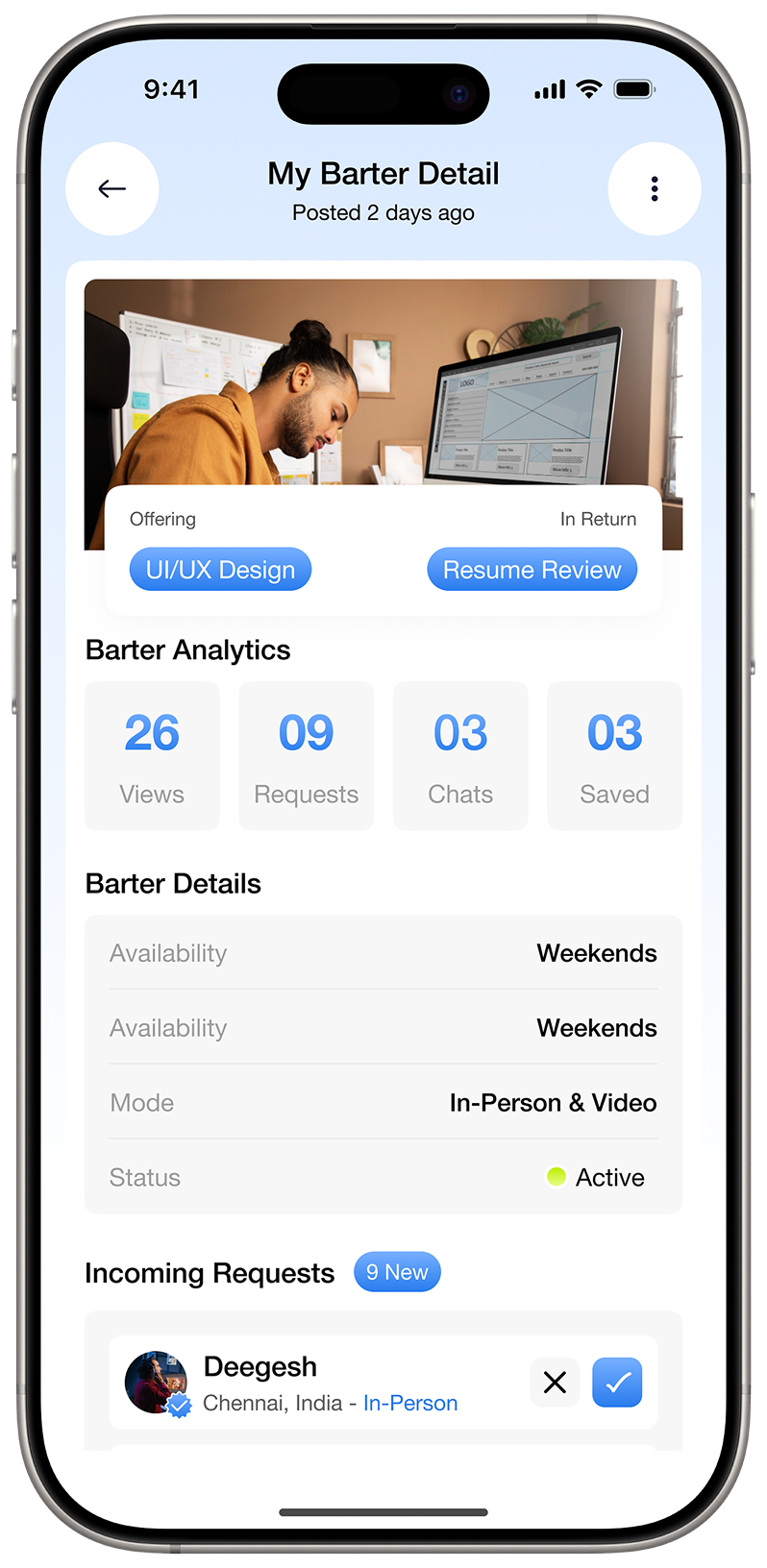
Barter Owner View: Requests & Insights
Creators can monitor engagement on their barter with real-time metrics and take action on incoming requests, all while keeping the full context of their barter visible for quick decision-making.
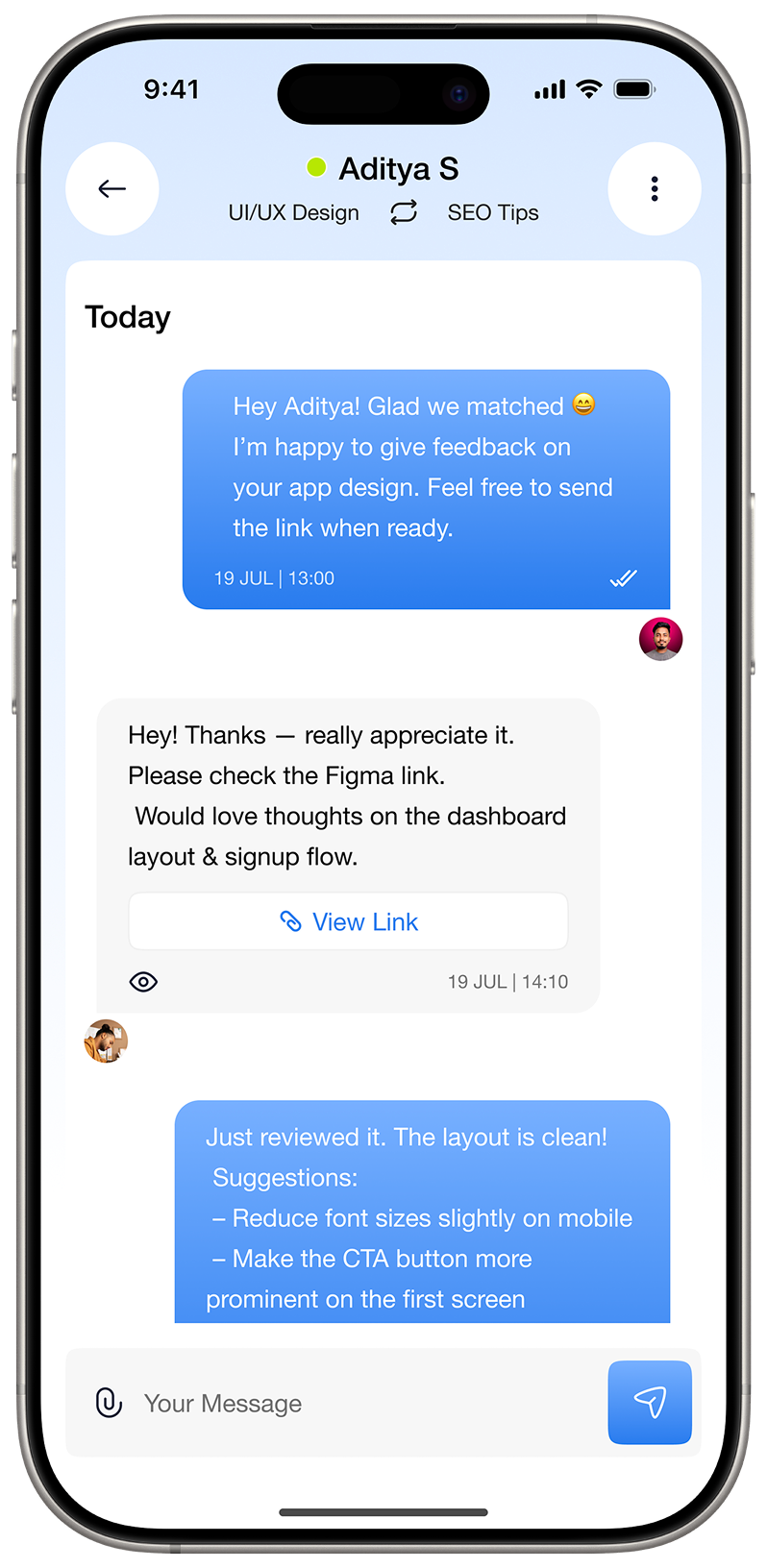
Seamless Communication Flow
The chat screen is designed to facilitate smooth coordination — showing barter context at the top, trust-building profile info, and a clean message thread. Users can discuss availability, share files, and finalize the skill exchange seamlessly.
Explore the Full Experience
A realistic preview of the app's interface and user flow, captured through the final prototype screens.
What I Learned...
A reflection on the key design choices, user insights, and lessons that shaped the final product.
User-Centered Design Wins :
Prioritizing flexibility (like "Skip for now" and optional location access) helped reduce barriers and build early trust with users.
Clarity Over Complexity :
Minimal onboarding, focused home layout, and clearly framed barter details made the app intuitive and action-driven.
Trust is a Feature, Not a Bonus :
Features like ratings, completed barter counts, and testimonials were essential in establishing confidence between users.
Micro-Actions, Macro Impact :
Small touches like "Save Barter" and "Add Note" during requests added layers of intent, helping users feel in control.
Consistency Across Flows :
Keeping visual and interaction patterns consistent — from chat to barter to profile — resulted in a seamless and scalable UX.
Still Here?
You're My Kind of User.
Let's swap ideas, feedback, or even a coffee.
